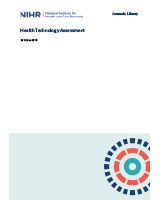This work was produced by Westwood et al. under the terms of a commissioning contract issued by the Secretary of State for Health and Social Care. This is an Open Access publication distributed under the terms of the Creative Commons Attribution CC BY 4.0 licence, which permits unrestricted use, distribution, reproduction and adaptation in any medium and for any purpose provided that it is properly attributed. See: https://creativecommons.org/licenses/by/4.0/. For attribution the title, original author(s), the publication source – NIHR Journals Library, and the DOI of the publication must be cited.
NCBI Bookshelf. A service of the National Library of Medicine, National Institutes of Health.
Westwood M, Armstrong N, Krijkamp E, et al. A cloud-based medical device for predicting cardiac risk in suspected coronary artery disease: a rapid review and conceptual economic model. Southampton (UK): National Institute for Health and Care Research; 2024 Jul. (Health Technology Assessment, No. 28.31.)

A cloud-based medical device for predicting cardiac risk in suspected coronary artery disease: a rapid review and conceptual economic model.
Show detailsThe overall aim of this project is to provide a comprehensive summary of all available evidence that may be relevant to the evaluation of CaRi-Heart® [a cloud-based CE-marked medical device (Caristo Diagnostics Ltd, Oxford, UK) that analyses images from computed tomography coronary angiography (CTCA) scans to provide information about inflammation in the coronary arteries], as an adjunctive investigation for assessment of cardiac risk, in people with stable chest pain/suspected coronary artery disease (CAD), who are undergoing CTCA. This assessment does not include the development of an executable cost-effectiveness model but does include conceptual modelling which explores the structure and evidence about parameters required for model development (see Chapter 5).
Current National Institute for Health and Care Excellence (NICE) guidelines do not include recommendations about the use of formal risk assessment tools, or intervention(s) based on specific risk thresholds, in this patient group. This Early Value Assessment (EVA), therefore, includes exploration of the potential clinical consequences of the availability of additional risk information from CaRi-Heart.
Given the anticipated limitations of the evidence base, the NICE scope for this assessment1 is broad and includes some evidence about secondary outcomes (Table 1). These outcomes may be used to inform consideration of the potential benefits of implementing CaRi-Heart, as specified in the scope, and to guide further research to enable full assessment of clinical efficacy and safety.
TABLE 1
Inclusion criteria
Based on the NICE scope,1 we have defined a series of research questions that could inform both a full assessment of the clinical and cost effectiveness of using CaRi-Heart, as an adjunctive investigation for assessment of cardiac risk, in people with stable chest pain/suspected CAD, who are undergoing CTCA and consideration of the potential of this technology to be cost-effective:
- What is the prognostic performance of CaRi-Heart, in people with stable chest pain, who are undergoing CTCA, where:
- the dependent variable is cardiac death?
- the dependent variable is other major adverse cardiovascular events (MACE)?
- What are the clinical effects of using CaRi-Heart to assess cardiac risk?
- What are the costs, from a UK NHS and Personal Social Services (PSS) perspective, using CaRi-Heart, as an adjunctive investigation for assessment of cardiac risk, in people with stable chest pain, who are undergoing CTCA?
- How might a conceptual model be specified in terms of structure and evidence required for parameterisation in order to estimate the cost effectiveness of CaRi-Heart in people with stable chest pain, who are undergoing CTCA?
The above questions were defined in line with the NICE scope1 and have been used to inform the inclusion criteria for the rapid review component of this assessment (see Table 1). In addition to the rapid review, evidence that may be required to inform parameterisation of a future cost-effectiveness model has been explored, as part of the conceptual modelling process (see What are the costs, from a UK NHS and Personal Social Services perspective, of using CaRi-Heart, as an adjunctive investigation for assessment of cardiac risk, in people with stable chest pain, who are undergoing computed tomography coronary angiography? and Chapter 5), using a pragmatic, iterative searching approach; model parameterisation questions, other than costs, were not included in the rapid review.
The available evidence is summarised, with consideration of its relevance to the above research questions, and a detailed description of evidence gaps where further research is needed is provided (see Strengths and limitations).
- Objective - A cloud-based medical device for predicting cardiac risk in suspecte...Objective - A cloud-based medical device for predicting cardiac risk in suspected coronary artery disease: a rapid review and conceptual economic model
- Assessment of existing cost-effectiveness evidence - Non-invasive imaging softwa...Assessment of existing cost-effectiveness evidence - Non-invasive imaging software to assess the functional significance of coronary stenoses: a systematic review and economic evaluation
- Extension to longitudinal data structures - Evaluation and validation of social ...Extension to longitudinal data structures - Evaluation and validation of social and psychological markers in randomised trials of complex interventions in mental health: a methodological research programme
- Discussion and conclusions - Echocardiography in newly diagnosed atrial fibrilla...Discussion and conclusions - Echocardiography in newly diagnosed atrial fibrillation patients: a systematic review and economic evaluation
- HSC2TB062 normalized infant brain cDNA Homo sapiens cDNA clone c-2tb06 3', mRNA ...HSC2TB062 normalized infant brain cDNA Homo sapiens cDNA clone c-2tb06 3', mRNA sequencegi|677969|gnl|dbEST|129397|emb|F088Nucleotide
Your browsing activity is empty.
Activity recording is turned off.
See more...